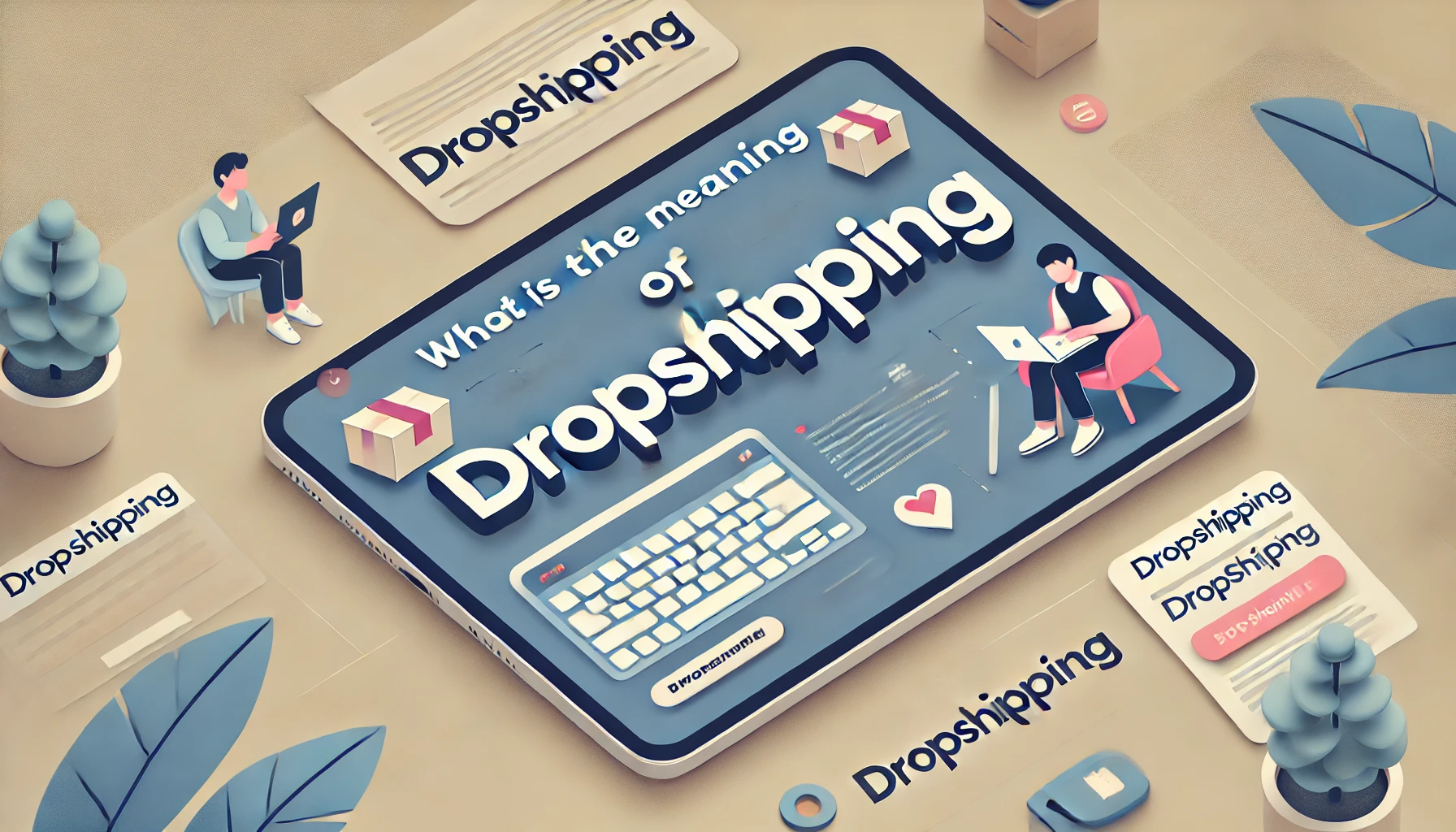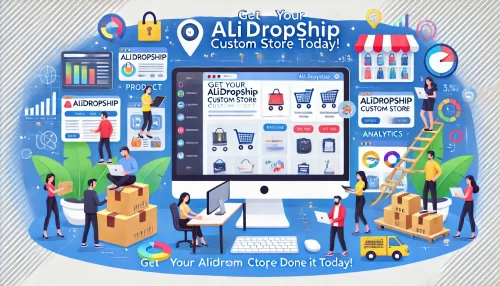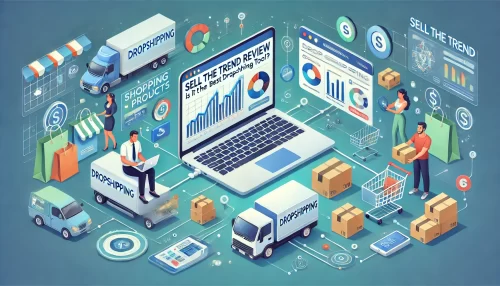What is dropshipping meaning, and how does it impact the world of ecommerce? This guide explores the essentials, benefits, and challenges, giving you a comprehensive look at dropshipping and how to start.
Dropshipping Meaning: A Simple Explanation
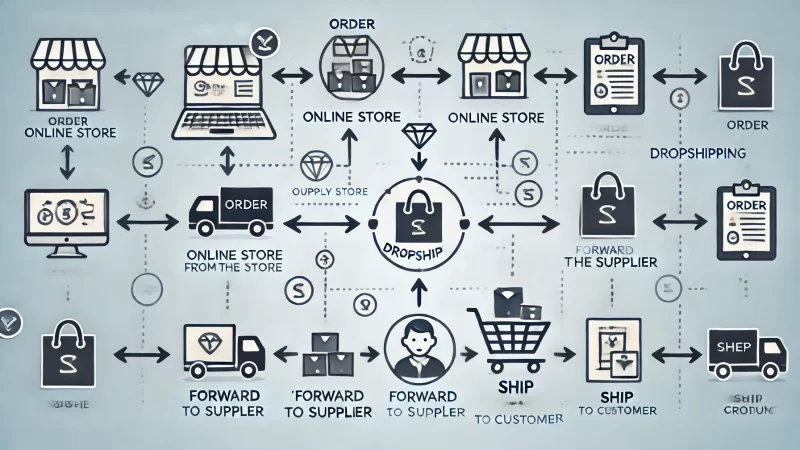
The dropshipping meaning revolves around a retail model where sellers don’t stock products. Instead, sellers pass customer orders to suppliers who ship directly, reducing costs and risks. This approach makes starting an online business accessible and flexible.
What Exactly Is Dropshipping?
Dropshipping allows retailers to sell products without handling them physically. When a customer buys an item, the retailer forwards the order to a supplier, who manages storage and shipping. This process keeps operations lean and startup costs low.
Sellers in dropshipping focus on marketing and sales, while suppliers oversee inventory. Retailers only buy products after customers place orders, meaning there’s no upfront investment in stock. I recommend this model for entrepreneurs seeking simplicity.
Since dropshipping eliminates warehousing, retailers face fewer logistical challenges. Suppliers ship products directly to buyers, reducing operational stress for sellers. It’s a model suited to those who prefer focusing on customer experience and branding.
Unlike traditional retail, dropshipping doesn’t require large financial commitments. Retailers avoid expenses like storage and packaging, making it feasible to start small and grow. This flexibility is a significant advantage for new business owners.
How Dropshipping Differs From Traditional Retail
Traditional retail models involve purchasing, storing, and managing products. In dropshipping, however, suppliers handle inventory and fulfillment, removing these responsibilities from retailers. This difference makes dropshipping a lower-risk option for many startups.
Dropshipping retailers have more flexibility in product offerings, as they aren’t limited by storage constraints. They can test products and adapt quickly, which I believe is crucial for staying competitive in today’s fast-paced markets.
Traditional retail often involves high overhead costs, with investments in inventory and warehousing. In contrast, dropshipping operates with minimal upfront costs, allowing entrepreneurs to enter the market without heavy financial burdens.
Customer demand drives inventory needs in dropshipping, not pre-purchased stock. This structure minimizes financial risk, as products are only bought after they’re sold. It’s an efficient, customer-driven model that aligns well with online retail trends.
Why Dropshipping Is Gaining Popularity
Dropshipping is gaining traction due to its low-cost entry and adaptability. Entrepreneurs appreciate the ability to start businesses with minimal investment, which I believe makes dropshipping especially appealing to new and small-scale ventures.
This model requires less commitment to inventory, so entrepreneurs can test various niches. Dropshipping also offers global reach, letting businesses sell worldwide without maintaining international warehouses, which makes it ideal for ambitious, budget-conscious retailers.
The rise of ecommerce platforms has simplified dropshipping setup, making it more accessible than ever. Anyone can launch a store with tools that handle orders, inventory, and shipping, which democratizes the opportunity for business ownership.
Dropshipping’s appeal also lies in its scalability. Sellers can add products quickly, responding to demand without investing in new stock. This dynamic approach allows entrepreneurs to adapt and grow their businesses according to customer interest.
How Does Dropshipping Work Step-By-Step?
Dropshipping follows a structured process that includes choosing a platform, finding suppliers, and managing orders. Each step is vital for creating a seamless, successful store that provides a positive experience for customers.
The Key Players in Dropshipping
The primary players in dropshipping include the retailer, the supplier, and the customer. Retailers handle marketing and sales, suppliers manage storage and shipping, and customers receive products directly from the supplier’s warehouse.
Each role is distinct but interconnected. Retailers work closely with suppliers to ensure product availability and quality, which directly affects customer satisfaction. I recommend building strong supplier relationships to maintain a smooth operation.
Suppliers play a crucial role in fulfilling orders accurately and on time. Since they handle shipping, their reliability is essential for customer trust. Choosing dependable suppliers is key to creating a reputable dropshipping business.
Customers interact mainly with the retailer, so it’s vital for retailers to provide clear communication and support. While suppliers handle logistics, retailers must ensure customers feel valued and informed about their orders, enhancing satisfaction.
Step 1: Setting Up a Dropshipping Store
Setting up a dropshipping store starts with choosing a platform like Shopify or Bigcommerce. These platforms offer integrations with suppliers, simplifying inventory management, order processing, and payment collection for a seamless store experience.
A user-friendly website layout is crucial. I suggest creating a clean, intuitive design that highlights product categories and details. This approach improves navigation and encourages customers to explore, which boosts engagement and sales.
Selecting products wisely is another key step. Consider trending items and niche markets with demand but less competition. Targeting the right products can help attract a specific audience and establish a solid brand presence.
Effective product descriptions and visuals enhance the customer experience. I recommend using high-quality images and detailed descriptions to convey product value, helping customers make informed purchase decisions and feel confident in their choices.
Step 2: Partnering With Reliable Suppliers
Reliable suppliers ensure quality and timely delivery, essential for customer trust. Research suppliers to find those with positive reviews, a solid reputation, and efficient shipping options that match your store’s needs and your customers’ expectations.
Testing products is a good practice before committing to a supplier. Ordering samples helps you verify quality, packaging, and shipping speed. I advise selecting suppliers who prioritize quality, as this directly impacts customer satisfaction.
Clear communication with suppliers is vital. Establish a process for tracking inventory, updating listings, and handling returns. Maintaining open channels with suppliers ensures you can manage stock levels and meet customer demands effectively.
Building long-term supplier relationships creates stability. I suggest fostering partnerships based on trust and reliability, as dependable suppliers contribute to a smoother operation and help you build a brand customers can count on.
Step 3: Managing Orders and Fulfillment
Order management is streamlined in dropshipping, as orders are sent directly to suppliers for fulfillment. Retailers coordinate with suppliers to track orders, keeping customers informed on their order’s status, which helps build transparency and trust.
Automation tools make order processing efficient. Many platforms offer order management software that links with suppliers, reducing manual work. I recommend these tools to keep operations efficient and ensure orders are processed smoothly.
Tracking shipments is crucial for customer satisfaction. Retailers should monitor orders until they reach customers, addressing any issues promptly. This level of attentiveness builds a positive reputation and encourages repeat business.
Order management also includes handling returns and refunds. A clear return policy simplifies this process. I advise creating a straightforward policy that outlines steps and timelines, helping customers feel secure and respected.
Step 4: Handling Customer Support
Customer support is essential, as it directly affects customer loyalty. Retailers manage inquiries, complaints, and returns, providing reassurance and guidance that make customers feel valued and more likely to return.
Clear communication builds trust. Responding quickly to customer questions or concerns, especially about orders or delays, shows dedication. I believe good support transforms a transaction into a relationship, strengthening brand loyalty.
Establishing a detailed FAQ section can reduce customer support needs. By addressing common questions about shipping, returns, and product care, you can offer helpful resources, making it easier for customers to find answers independently.
Handling complaints gracefully is key. I recommend listening to customer concerns and offering practical solutions. This approach demonstrates professionalism and commitment, showing customers that you genuinely value their experience.
Pros and Cons of Dropshipping Explained
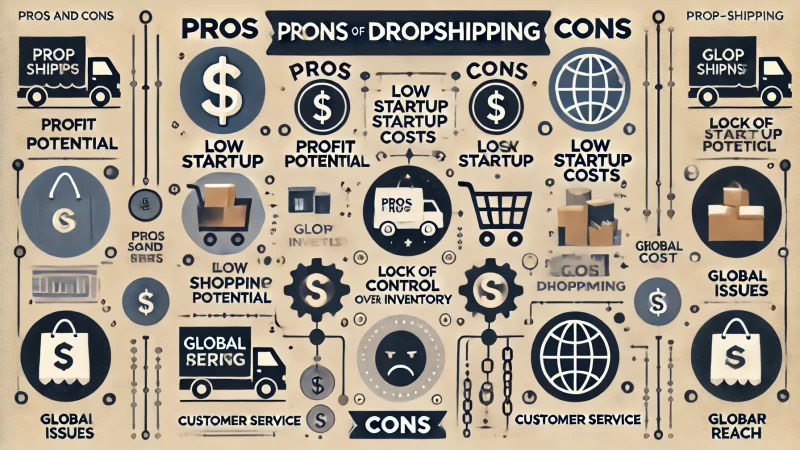
Dropshipping comes with unique advantages and challenges. While it’s accessible and affordable for new entrepreneurs, it also presents certain operational hurdles. Understanding both sides will help you decide if it’s right for your goals.
Benefits of Dropshipping for New Entrepreneurs
Dropshipping allows entrepreneurs to start with minimal financial risk, as there’s no need for inventory. This flexibility enables sellers to explore various products without a large upfront investment, making it ideal for new business owners.
Another key benefit is operational simplicity. Retailers focus on sales and customer service, while suppliers handle warehousing and shipping. This division reduces overhead and lets you focus on customer acquisition and marketing.
Dropshipping’s scalability is a major advantage. As your business grows, adding new products or adjusting inventory is easy, making dropshipping adaptable to market trends. I recommend this model for those seeking flexibility and growth potential.
Testing products and niches is also simple with dropshipping. You can quickly switch products based on demand without risk, allowing for experimentation. This approach offers valuable insights into customer preferences without significant financial commitments.
Common Dropshipping Challenges and How to Overcome Them
One of the main challenges is shipping delays, especially if suppliers are international. Clear communication about shipping times helps manage customer expectations. I suggest being upfront to avoid disappointment and maintain trust.
Another challenge is quality control since you’re not handling products directly. To counter this, I recommend choosing suppliers with high standards and positive reviews. Requesting product samples also ensures quality aligns with your brand’s values.
Profit margins can be low in dropshipping due to supplier fees and competitive pricing. Finding a niche with less competition and offering premium customer service can help. I advise focusing on value-added experiences to retain customers.
Handling returns can be complex, as suppliers dictate policies. Establishing a clear return process helps, making it easy for customers to understand. Good customer support during returns can turn a negative experience into a positive one.
When Dropshipping Is Ideal for Your Business Model
Dropshipping is well-suited for business models prioritizing flexibility and low initial costs. If you’re looking to test a business idea with minimal investment, dropshipping provides a practical way to enter ecommerce without heavy financial risks.
It’s also ideal for those interested in experimenting with different product niches. Dropshipping’s adaptable nature allows you to pivot if certain products underperform, which I believe is crucial in today’s fast-paced markets.
For businesses wanting to expand product lines without committing to inventory, dropshipping offers a solution. It allows established stores to test new categories without adding warehousing costs, making it a smart choice for growth.
Those focusing on building a brand through unique customer experiences may find dropshipping beneficial. You can focus on creating a strong brand identity, customer service, and marketing while leaving logistics to reliable suppliers.
Popular Dropshipping Niches To Consider
Choosing the right niche is essential for dropshipping success. Some niches show higher demand and profitability, making them attractive options. This section explores profitable niches and tips for selecting one that suits your goals.
Profitable Niches for Dropshipping in 2024
The health and wellness niche remains strong in 2024, including products like fitness equipment and supplements. Consumers prioritize well-being, creating steady demand. I suggest exploring sub-niches here, like sustainable wellness products.
Eco-friendly products are also gaining traction. Items like reusable household goods appeal to environmentally conscious buyers. Dropshipping eco-friendly products taps into a growing audience interested in reducing waste and supporting green businesses.
Pet supplies continue to be profitable, with pet owners willing to invest in their pets’ comfort and health. Unique pet items, like personalized collars or interactive toys, can attract loyal customers, especially in the premium pet market.
Home office products have become popular with the rise of remote work. Ergonomic furniture and tech accessories are in demand as people create efficient workspaces. This niche is adaptable and has long-term growth potential.
How to Choose a Niche That Sells
To choose a profitable niche, analyze trends and consider your interests. I suggest selecting a niche you’re passionate about; it makes researching and promoting products more enjoyable, leading to a better understanding of your audience.
Assess competition within potential niches. Low-competition niches with steady demand offer a better chance for growth. Keyword research tools can reveal niche-specific search volume, helping you gauge market interest effectively.
Consider the audience’s purchasing behavior. Niches with repeat-purchase potential, like pet supplies or beauty products, often see better retention. Products that customers buy regularly can create a stable revenue stream.
Think about seasonality. Some products sell well year-round, while others are seasonal. Understanding demand cycles lets you plan inventory better, ensuring a steady flow of customers without worrying about peak periods only.
Tips for Staying Competitive in Your Niche
To remain competitive, continually update your product catalog. Refreshing your offerings keeps customers engaged, especially if you’re in a niche with frequent trends or new releases. Staying relevant can build customer loyalty over time.
Focus on branding. Creating a unique brand identity helps differentiate you from other dropshippers. I recommend a strong brand voice and visuals that resonate with your target audience, as this builds trust and recognition.
Offer excellent customer service. Responding quickly to questions and handling issues well can set you apart in a competitive market. Exceptional service creates a positive impression, increasing the likelihood of repeat purchases and referrals.
Stay informed about trends and competitor strategies. Regularly reviewing industry news and competitor products helps you adjust your offerings. Adapting quickly to changes keeps you ahead, giving your store a unique edge.
Essential Tools for Dropshipping Success

Essential tools streamline dropshipping operations, from managing orders to driving sales. Using reliable platforms and apps ensures smoother operations and helps you maintain a positive customer experience while scaling effectively.
Best Platforms for Launching a Dropshipping Store
Shopify is a popular platform, known for its dropshipping integrations and ease of use. It provides an all-in-one solution, allowing you to manage inventory, process payments, and customize your store layout for a professional look.
WooCommerce is another option, especially for WordPress users. It’s highly customizable and integrates well with dropshipping plugins. I recommend WooCommerce if you want a flexible, self-hosted solution with extensive customization options.
BigCommerce offers a robust dropshipping platform with built-in SEO tools and customizable themes. It’s scalable, making it suitable for larger stores. This platform’s features can help you optimize store performance as you grow.
Ecwid is an affordable, easy-to-use platform for smaller stores. Its simplicity and compatibility with various sales channels make it ideal for those new to dropshipping. Ecwid’s user-friendly design simplifies setup and management.
Recommended Apps for Streamlining Operations
Oberlo, a Shopify app, simplifies sourcing products and managing orders. It automates order fulfillment and tracks inventory, allowing you to focus on customer experience. I recommend Oberlo for efficient product management.
Spocket connects you with suppliers closer to your target market, reducing shipping times. This app emphasizes local and US-based suppliers, making it an excellent choice for quick deliveries and reliable quality control.
AliExpress Dropshipping is another popular option, offering a wide range of products. Many dropshipping platforms integrate with AliExpress, letting you source items easily. I advise AliExpress Dropshipping for its extensive product variety.
DSers helps you manage bulk orders from AliExpress, saving time on order fulfillment. It’s efficient for stores with higher sales volume, enabling faster processing. DSers’ bulk order management is invaluable for streamlining operations.
Tools for Marketing and Driving Sales
Omnisend is a powerful email marketing tool that integrates well with dropshipping platforms. It allows personalized email campaigns based on customer behavior. I suggest Klaviyo for targeted, data-driven email marketing.
Google Analytics helps you track visitor behavior, revealing insights about your audience and how they interact with your site. Understanding these patterns allows you to optimize marketing efforts and improve conversions over time.
Facebook Ads Manager is crucial for targeted social media advertising. Running ads on Facebook or Instagram can boost traffic and sales. I believe Facebook Ads are essential for dropshippers, especially when reaching niche audiences.
Canva is a versatile design tool for creating social media graphics, ads, and product images. High-quality visuals engage customers and enhance brand perception. I recommend Canva to elevate your store’s branding and marketing efforts.
Key Strategies to Maximize Dropshipping Profits
Maximizing profits in dropshipping requires a combination of effective marketing, strategic pricing, and a focus on customer satisfaction. These strategies create a well-rounded approach that helps boost sales and encourages long-term customer loyalty.
Effective Marketing Techniques for Dropshipping
Social media marketing can drive engagement and sales by showcasing products in creative ways. Platforms like Instagram and Facebook allow you to reach targeted audiences. I recommend using eye-catching visuals to attract potential buyers effectively.
Email marketing is a powerful tool for customer retention. Sending personalized offers and updates keeps customers engaged with your brand. I suggest building an email list early to maintain ongoing communication and encourage repeat purchases.
Influencer partnerships offer credibility and expand your reach. Collaborating with influencers in your niche introduces your products to their followers. This approach can generate interest and trust, which translates to increased sales over time.
Retargeting ads remind visitors who haven’t purchased to return. Many potential customers need multiple exposures before deciding, so retargeting can help. It’s a useful tactic that reinforces brand recall and boosts conversion rates.
How to Price Products for Higher Profit Margins
Research competitor prices to establish a pricing baseline. While underpricing may attract buyers, it can cut profits. I suggest finding a balance that highlights value, giving customers a reason to choose your products.
Offer bundles or discounts on multi-item purchases. Bundling can increase average order value and enhance perceived savings for customers. I believe it’s a strategic way to boost profits without discounting individual items significantly.
Highlight product value in your descriptions. Emphasizing benefits justifies a higher price, especially if you’re targeting a premium market. I recommend focusing on quality, features, or exclusivity to make customers feel the price is worth it.
Consider seasonal pricing adjustments. High-demand seasons may support slightly higher prices, while sales events attract budget-conscious buyers. This flexible pricing strategy can adapt to customer demand, maximizing profitability throughout the year.
Optimizing Customer Experience to Boost Retention
Customer support plays a vital role in retention. Prompt responses build trust and make customers feel valued. I suggest investing in responsive support channels to create a positive experience that encourages repeat purchases.
Fast and reliable shipping enhances satisfaction. Partnering with dependable suppliers ensures timely deliveries, boosting customer confidence. I recommend keeping customers updated on order status to reduce anxiety and enhance trust.
Personalizing the shopping experience adds value. Offering tailored product recommendations based on past purchases creates a memorable interaction. This personalized touch shows customers you care, which fosters loyalty and repeat business.
Loyalty programs incentivize repeat purchases. Offering rewards like discounts or exclusive offers for repeat buyers encourages ongoing engagement. I believe loyalty programs turn one-time buyers into loyal customers, enhancing long-term profits.
How to Start Dropshipping With Low Capital

Starting dropshipping with low capital is possible by focusing on budget-friendly tools and strategies. With the right approach, you can minimize initial expenses while building a profitable store that’s ready to grow as sales increase.
Budget-Friendly Tips for New Dropshippers
Begin with a simple, low-cost ecommerce platforms like Appscenic and WooCommerce. These platforms provide essential tools without high fees. I recommend starting small, upgrading only as needed to control your expenses from the start.
Focus on affordable marketing channels, like social media and organic search. Creating valuable content on platforms like Instagram can attract customers without ad costs. I believe organic growth is sustainable and perfect for tight budgets.
Use free tools for essential tasks. Apps like Canva for design and Google Analytics for tracking help you manage operations without spending. Leveraging these tools maintains quality while conserving resources, which is key in early stages.
Choose suppliers with minimal upfront fees. Some suppliers offer products without setup fees, helping you keep costs low. I suggest finding suppliers that align with your budget to avoid unexpected costs that could strain your finances.
Free and Low-Cost Resources to Leverage
Social media offers a free platform for promoting your products. Creating engaging posts that showcase items can attract potential customers organically. I recommend building a consistent posting schedule to keep your brand visible.
Free email marketing tools, like Aweber basic plan, allow you to start building customer lists. Emails keep customers informed and engaged, driving repeat sales. This approach is cost-effective for maintaining a customer connection.
Trial versions of paid apps help you test features without commitment. Many dropshipping apps offer free trials, so you can evaluate their benefits. I suggest using trials to find tools that fit your needs without immediate expenses.
YouTube tutorials provide valuable insights on managing a dropshipping store. Free learning resources help you master skills and avoid common mistakes. I advise taking advantage of tutorials to improve your knowledge at no cost.
Overcoming Financial Barriers in Dropshipping
Consider starting with low-cost products that appeal to budget-conscious buyers. This strategy allows you to reach customers quickly without high costs. I believe targeting affordable products makes it easier to launch with minimal investment.
Limit paid advertising until you see consistent sales. Focusing on organic growth channels keeps costs down, allowing you to allocate funds only when needed. This conservative approach helps you stay within budget while expanding gradually.
Monitor expenses closely. Tracking every cost ensures you understand your financial health, helping you make informed decisions. I recommend using budgeting tools to stay on top of finances, especially during the early stages of your business.
Use profits for reinvestment. As your store grows, allocate earnings toward expanding your product range or improving customer service. This reinvestment cycle supports sustainable growth without the need for large, upfront investments.
Avoiding Common Dropshipping Mistakes
Avoiding common pitfalls in dropshipping saves time and money. Many new dropshippers encounter avoidable errors that hinder growth. This section offers guidance on sidestepping these mistakes to run a smoother, more profitable store.
Mistakes New Dropshippers Make and How to Avoid Them
Relying on a single supplier can be risky. If that supplier faces delays, it affects your business. I suggest partnering with multiple suppliers to maintain consistent product availability and avoid disruptions.
Neglecting product research leads to poor sales. Some products may have low demand or high competition. Conducting research helps you find viable items. I advise using keyword tools to identify products with steady demand.
Failing to set realistic expectations can cause frustration. Success takes time, so I recommend setting achievable goals and viewing dropshipping as a long-term venture. Patience and persistence are key to seeing meaningful results.
Ignoring customer feedback can harm your reputation. Listening to customer suggestions helps you improve. I recommend regularly reviewing feedback and implementing necessary changes to enhance satisfaction and build trust.
Tips for Managing Supplier Relationships
Good communication is essential for strong supplier relationships. Regular updates on inventory and shipping help avoid surprises. I believe maintaining clear communication reduces misunderstandings and ensures smooth operations.
Choose suppliers that align with your quality standards. Reliable suppliers provide consistent product quality, which is crucial for customer satisfaction. Testing products before committing ensures they meet your expectations and those of your customers.
Negotiating prices with suppliers can improve your profit margins. Many suppliers are open to discounts for bulk orders. I recommend discussing pricing with suppliers to secure better rates, especially as your order volume grows.
Building trust with suppliers fosters loyalty. Treating suppliers with respect and professionalism encourages them to prioritize your orders. Positive relationships with suppliers contribute to a smoother, more reliable dropshipping operation.
Building a Long-Term Dropshipping Business
Focus on brand building rather than quick profits. A unique brand differentiates your store from competitors. I suggest creating a strong brand identity to attract loyal customers and build a business with lasting impact.
Invest in quality customer service. Prompt responses and genuine interactions foster customer loyalty. A commitment to excellent service builds trust and reputation, setting you apart from other dropshipping stores.
Analyze data regularly to identify trends. Reviewing sales data and customer preferences helps you refine your product offerings. I recommend using data to make strategic decisions that align with your audience’s interests.
Prepare for growth with scalable systems. As your business expands, having efficient tools and processes supports growth without disruption. I advise setting up systems that adapt to higher order volumes, ensuring long-term success.
Frequently Asked Questions
What is dropshipping, and how does it work?
Dropshipping is a business model where retailers sell products without holding inventory. When a customer places an order, the retailer forwards it to a supplier, who then ships the product directly to the customer. This setup minimizes upfront costs and inventory management for the retailer, making it a low-risk option for new entrepreneurs.
How is dropshipping different from traditional retail?
In traditional retail, sellers purchase inventory, store it, and manage shipping themselves. Dropshipping removes these responsibilities by having suppliers handle the inventory and shipping, allowing retailers to focus solely on marketing and customer service.
Why is dropshipping becoming so popular?
Dropshipping’s popularity is growing because it has a low barrier to entry, requires minimal upfront investment, and allows sellers to run a business without managing physical inventory. This model is especially attractive to entrepreneurs looking for flexible, scalable business options.
Can anyone start a dropshipping business with limited capital?
Yes, dropshipping is particularly well-suited for individuals with limited capital. Since there’s no need to buy inventory upfront, costs are primarily limited to setting up an online store, marketing, and choosing a reliable platform, making it possible to start small and scale as the business grows.
What are the main advantages of dropshipping?
Key advantages include low startup costs, flexibility in product offerings, and reduced logistical demands. Dropshipping also allows business owners to test different products or niches without significant financial risk, making it ideal for experimenting and finding successful products.
What are the biggest challenges with dropshipping?
Challenges include potential shipping delays, reliance on supplier quality, low profit margins, and handling customer support for returns and complaints. Finding reliable suppliers and managing customer expectations around delivery times are crucial to overcoming these obstacles.
How can I find trustworthy suppliers for my dropshipping business?
Researching suppliers thoroughly is essential. Look for suppliers with positive reviews, a track record of quality, and reliable shipping options. Many platforms, such as Spocket and AliExpress, specialize in dropshipping and provide easy access to vetted suppliers.
Do I need a website to start dropshipping?
Yes, having a professional website is essential for credibility and smooth operations. Platforms like Shopify, WooCommerce, and BigCommerce make it easy to set up a dropshipping website and integrate directly with suppliers for streamlined order processing.
What are the most profitable niches for dropshipping in 2024?
Popular niches for dropshipping in 2024 include health and wellness products, eco-friendly items, pet supplies, and home office products. These niches are seeing increased demand and offer growth potential as consumer interest remains strong.
How do I choose a niche for my dropshipping store?
To choose a niche, consider factors like your interests, market demand, competition, and customer buying behavior. Selecting a niche that you’re passionate about can help with marketing and brand-building, while ensuring it has steady demand increases your chance of success.
What tools can help streamline dropshipping operations?
Several tools can make dropshipping easier. For example, Oberlo and Spocket help with sourcing products and managing orders. Marketing tools like Klaviyo for email and Canva for design support branding and customer engagement, helping you run a more efficient business.
How can I improve profit margins in dropshipping?
Improving profit margins involves careful pricing, negotiating better rates with suppliers, and adding value through branding and customer service. Offering bundles, focusing on quality, and targeting niche markets can also help you achieve better profit margins.
How do dropshipping returns work?
Returns in dropshipping typically follow the supplier’s return policy. As the retailer, you manage customer interactions, but the product return process usually involves the supplier. Clear communication with suppliers about return policies can help you set up a seamless process for customers.
What is the best way to handle customer service in a dropshipping business?
Good customer service is essential in dropshipping. Respond quickly to questions, provide order updates, and handle complaints professionally. Establishing an FAQ section and clear return policies can also help manage customer expectations and build trust.
How can I scale a dropshipping business?
Scaling a dropshipping business involves expanding product offerings, investing in marketing, and building a strong brand. Automation tools for order management and email marketing can streamline operations, while social media and paid ads can drive more traffic and sales.


